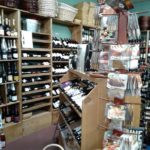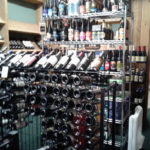Pricing tables
[trx_title type=”2″ align=”center”]Pricing tables[/trx_title]
[trx_button skin=”global” style=”bg” size=”big” fullsize=”no” icon=”icon-left-open-micro” align=”center” link=”/shortcodes/” target=”no” popup=”no” bottom=”30″]All shortcodes[/trx_button]
[trx_price_table align=”center” count=”4″ indent=”yes” style=”1″]
[trx_price_item animation=”yes”]
[trx_price_data type=”title”]Basic[/trx_price_data]
[trx_price_data type=”price” money=”89.99″ currency=”$” period=”monthly”][/trx_price_data]
[trx_price_data]1 Bottle[/trx_price_data]
[trx_price_data]1 Tour[/trx_price_data]
[trx_price_data]1 Wine Tasting[/trx_price_data]
[trx_price_data]1 Horse-back ride[/trx_price_data]
[trx_price_data]1 Winemaking Class [/trx_price_data]
[trx_price_data type=”footer”][trx_button skin=”global” style=”line” size=”mini” fullsize=”no” align=”none” link=”#” target=”no” popup=”no”]Sign Up[/trx_button][/trx_price_data]
[/trx_price_item]
[trx_price_item animation=”yes”]
[trx_price_data type=”title”]Standard[/trx_price_data]
[trx_price_data type=”price” money=”109.99″ currency=”$” period=”monthly”][/trx_price_data]
[trx_price_data]3 Bottles[/trx_price_data]
[trx_price_data]3 Tours[/trx_price_data]
[trx_price_data]3 Wine Tastings[/trx_price_data]
[trx_price_data]3 Horse-back rides[/trx_price_data]
[trx_price_data]3 Winemaking Classes [/trx_price_data]
[trx_price_data type=”footer”][trx_button skin=”global” style=”line” size=”mini” fullsize=”no” align=”none” link=”#” target=”no” popup=”no”]Sign Up[/trx_button][/trx_price_data]
[/trx_price_item]
[trx_price_item animation=”yes”]
[trx_price_data type=”title”]Premium[/trx_price_data]
[trx_price_data type=”price” money=”129.99″ currency=”$” period=”monthly”][/trx_price_data]
[trx_price_data]5 Bottles[/trx_price_data]
[trx_price_data]5 Tour[/trx_price_data]
[trx_price_data]5 Wine Tastings[/trx_price_data]
[trx_price_data]5 Horse-back rides[/trx_price_data]
[trx_price_data]5 Winemaking Classes [/trx_price_data]
[trx_price_data type=”footer”][trx_button skin=”global” style=”line” size=”mini” fullsize=”no” align=”none” link=”#” target=”no” popup=”no”]Sign Up[/trx_button][/trx_price_data]
[/trx_price_item]
[trx_price_item animation=”yes”]
[trx_price_data type=”title”]Gold[/trx_price_data]
[trx_price_data type=”price” money=”149.99″ currency=”$” period=”monthly”][/trx_price_data]
[trx_price_data]10 Bottles[/trx_price_data]
[trx_price_data]10 Tours[/trx_price_data]
[trx_price_data]10 Wine Tastings[/trx_price_data]
[trx_price_data]10 Horse-back rides[/trx_price_data]
[trx_price_data]10 Winemaking Classes [/trx_price_data]
[trx_price_data type=”footer”][trx_button skin=”global” style=”line” size=”mini” fullsize=”no” align=”none” link=”#” target=”no” popup=”no”]Sign Up[/trx_button][/trx_price_data]
[/trx_price_item]
[/trx_price_table]
[trx_line style=”solid” width=”50%” top=”30″ bottom=”50″ align=”center”]
[trx_price_table align=”center” count=”4″ indent=”yes” style=”3″ bottom=”30″]
[trx_price_item animation=”yes”]
[trx_price_data type=”title”]Basic[/trx_price_data]
[trx_price_data type=”price” money=”89.99″ currency=”$” period=”Monthly”][/trx_price_data]
[trx_price_data type=”regular”]1 Bottle[/trx_price_data]
[trx_price_data type=”regular”]1 Tour[/trx_price_data]
[trx_price_data type=”regular”]1 Class[/trx_price_data]
[trx_price_data type=”regular”][trx_icon icon=”icon-cancel”][/trx_price_data]
[trx_price_data type=”regular”][trx_icon icon=”icon-cancel”][/trx_price_data]
[trx_price_data type=”footer”][trx_button skin=”global” style=”line” size=”mini” fullsize=”no” align=”none” link=”#” target=”no” popup=”no”]Sign Up[/trx_button][/trx_price_data]
[/trx_price_item]
[trx_price_item animation=”yes”]
[trx_price_data type=”title”]Standard[/trx_price_data]
[trx_price_data type=”price” money=”109.99″ currency=”$” period=”Monthly”][/trx_price_data]
[trx_price_data type=”regular”]3 Bottles[/trx_price_data]
[trx_price_data type=”regular”]3 Tours[/trx_price_data]
[trx_price_data type=”regular”]3 Classes[/trx_price_data]
[trx_price_data type=”regular”][trx_icon icon=”icon-ok-1″][/trx_price_data]
[trx_price_data type=”regular”][trx_icon icon=”icon-cancel”][/trx_price_data]
[trx_price_data type=”footer”][trx_button skin=”global” style=”line” size=”mini” fullsize=”no” align=”none” link=”#” target=”no” popup=”no”]Sign Up[/trx_button][/trx_price_data]
[/trx_price_item]
[trx_price_item animation=”yes”]
[trx_price_data type=”title”]Premium[/trx_price_data]
[trx_price_data type=”price” money=”129.99″ currency=”$” period=”Monthly”][/trx_price_data]
[trx_price_data type=”regular”]5 Bottles[/trx_price_data]
[trx_price_data type=”regular”]5 Tours[/trx_price_data]
[trx_price_data type=”regular”]5 Classes[/trx_price_data]
[trx_price_data type=”regular”][trx_icon icon=”icon-ok-1″][/trx_price_data]
[trx_price_data type=”regular”][trx_icon icon=”icon-ok-1″][/trx_price_data]
[trx_price_data type=”footer”][trx_button skin=”global” style=”line” size=”mini” fullsize=”no” align=”none” link=”#” target=”no” popup=”no”]Sign Up[/trx_button][/trx_price_data]
[/trx_price_item]
[trx_price_item animation=”yes”]
[trx_price_data type=”title”]Gold[/trx_price_data]
[trx_price_data type=”price” money=”149.99″ currency=”$” period=”Monthly”][/trx_price_data]
[trx_price_data type=”regular”]10 Bottles[/trx_price_data]
[trx_price_data type=”regular”]10 Tours[/trx_price_data]
[trx_price_data type=”regular”]10 Classes[/trx_price_data]
[trx_price_data type=”regular”][trx_icon icon=”icon-ok-1″][/trx_price_data]
[trx_price_data type=”regular”][trx_icon icon=”icon-ok-1″][/trx_price_data]
[trx_price_data type=”footer”][trx_button skin=”global” style=”line” size=”mini” fullsize=”no” align=”none” link=”#” target=”no” popup=”no”]Sign Up[/trx_button][/trx_price_data]
[/trx_price_item]
[/trx_price_table]
[trx_line style=”solid” width=”50%” top=”30″ bottom=”50″ align=”center”]
[trx_price_table align=”center” count=”4″ indent=”yes” style=”2″ bottom=”30″]
[trx_price_item animation=”yes”]
[trx_price_data type=”title”]Basic[/trx_price_data]
[trx_price_data type=”price” money=”89.99″ currency=”$” period=”Monthly”][/trx_price_data]
[trx_price_data type=”regular”]1 Bottle[/trx_price_data]
[trx_price_data type=”regular”]1 Tour[/trx_price_data]
[trx_price_data type=”regular”]1 Class[/trx_price_data]
[trx_price_data type=”regular”][trx_icon icon=”icon-cancel”][/trx_price_data]
[trx_price_data type=”regular”][trx_icon icon=”icon-cancel”][/trx_price_data]
[trx_price_data type=”footer”][trx_button skin=”global” style=”bg” size=”mini” fullsize=”no” align=”none” link=”#” target=”no” popup=”no”]Sign Up[/trx_button][/trx_price_data]
[/trx_price_item]
[trx_price_item animation=”yes”]
[trx_price_data type=”title”]Standard[/trx_price_data]
[trx_price_data type=”price” money=”109.99″ currency=”$” period=”Monthly”][/trx_price_data]
[trx_price_data type=”regular”]3 Bottles[/trx_price_data]
[trx_price_data type=”regular”]3 Tours[/trx_price_data]
[trx_price_data type=”regular”]3 Classes[/trx_price_data]
[trx_price_data type=”regular”][trx_icon icon=”icon-ok-1″][/trx_price_data]
[trx_price_data type=”regular”][trx_icon icon=”icon-cancel”][/trx_price_data]
[trx_price_data type=”footer”][trx_button skin=”global” style=”bg” size=”mini” fullsize=”no” align=”none” link=”#” target=”no” popup=”no”]Sign Up[/trx_button][/trx_price_data]
[/trx_price_item]
[trx_price_item animation=”yes”]
[trx_price_data type=”title”]Premium[/trx_price_data]
[trx_price_data type=”price” money=”129.99″ currency=”$” period=”Monthly”][/trx_price_data]
[trx_price_data type=”regular”]5 Bottles[/trx_price_data]
[trx_price_data type=”regular”]5 Tours[/trx_price_data]
[trx_price_data type=”regular”]5 Classes[/trx_price_data]
[trx_price_data type=”regular”][trx_icon icon=”icon-ok-1″][/trx_price_data]
[trx_price_data type=”regular”][trx_icon icon=”icon-ok-1″][/trx_price_data]
[trx_price_data type=”footer”][trx_button skin=”global” style=”bg” size=”mini” fullsize=”no” align=”none” link=”#” target=”no” popup=”no”]Sign Up[/trx_button][/trx_price_data]
[/trx_price_item]
[trx_price_item animation=”yes”]
[trx_price_data type=”title”]Gold[/trx_price_data]
[trx_price_data type=”price” money=”149.99″ currency=”$” period=”Monthly”][/trx_price_data]
[trx_price_data type=”regular”]10 Bottles[/trx_price_data]
[trx_price_data type=”regular”]10 Tours[/trx_price_data]
[trx_price_data type=”regular”]10 Classes[/trx_price_data]
[trx_price_data type=”regular”][trx_icon icon=”icon-ok-1″][/trx_price_data]
[trx_price_data type=”regular”][trx_icon icon=”icon-ok-1″][/trx_price_data]
[trx_price_data type=”footer”][trx_button skin=”global” style=”bg” size=”mini” fullsize=”no” align=”none” link=”#” target=”no” popup=”no”]Sign Up[/trx_button][/trx_price_data]
[/trx_price_item]
[/trx_price_table]
[trx_line style=”solid” width=”50%” top=”30″ bottom=”50″ align=”center”]
[trx_price_table align=”center” count=”3″ indent=”yes” style=”2″ bottom=”0″]
[trx_price_item animation=”no”]
[trx_price_data type=”image” image=”http://wine.themerex.net/wp-content/uploads/2014/11/picjumbo.com_IMG_6296.jpg”][/trx_price_data]
[trx_price_data type=”price” money=”89.99″ currency=”$” period=”Monthly”][/trx_price_data]
[trx_price_data type=”regular”]1 Splendide philosophia et[/trx_price_data]
[trx_price_data type=”regular”]Cum at probo / minimum[/trx_price_data]
[trx_price_data type=”regular”]Falli libris has id facer[/trx_price_data]
[trx_price_data type=”regular”]Pertinax vel eum ne molestie[/trx_price_data]
[trx_price_data type=”footer”][trx_button skin=”global” style=”bg” size=”mini” fullsize=”no” align=”none” link=”#” target=”no” popup=”no”]Sign Up[/trx_button][/trx_price_data]
[/trx_price_item]
[trx_price_item animation=”no”]
[trx_price_data type=”image” image=”http://wine.themerex.net/wp-content/uploads/2014/09/kaboompics.com_Bottle-of-wine2.jpg”][/trx_price_data]
[trx_price_data type=”price” money=”129.99″ currency=”$” period=”Monthly”][/trx_price_data]
[trx_price_data type=”regular”]5 Splendide philosophia et[/trx_price_data]
[trx_price_data type=”regular”]Cum at probo / minimum[/trx_price_data]
[trx_price_data type=”regular”]Falli libris has id facer[/trx_price_data]
[trx_price_data type=”regular”]Pertinax vel eum ne molestie[/trx_price_data]
[trx_price_data type=”footer”][trx_button skin=”global” style=”bg” size=”mini” fullsize=”no” align=”none” link=”#” target=”no” popup=”no”]Sign Up[/trx_button][/trx_price_data]
[/trx_price_item]
[trx_price_item animation=”no”]
[trx_price_data type=”image” image=”http://wine.themerex.net/wp-content/uploads/2014/09/Depositphotos_5374778_l1.jpg”][/trx_price_data]
[trx_price_data type=”price” money=”149.99″ currency=”$” period=”Monthly”][/trx_price_data]
[trx_price_data type=”regular”]10 Splendide philosophia et[/trx_price_data]
[trx_price_data type=”regular”]Cum at probo / minimum[/trx_price_data]
[trx_price_data type=”regular”]Falli libris has id facer[/trx_price_data]
[trx_price_data type=”regular”]Pertinax vel eum ne molestie[/trx_price_data]
[trx_price_data type=”footer”][trx_button skin=”global” style=”bg” size=”mini” fullsize=”no” align=”none” link=”#” target=”no” popup=”no”]Sign Up[/trx_button][/trx_price_data]
[/trx_price_item]
[/trx_price_table]










